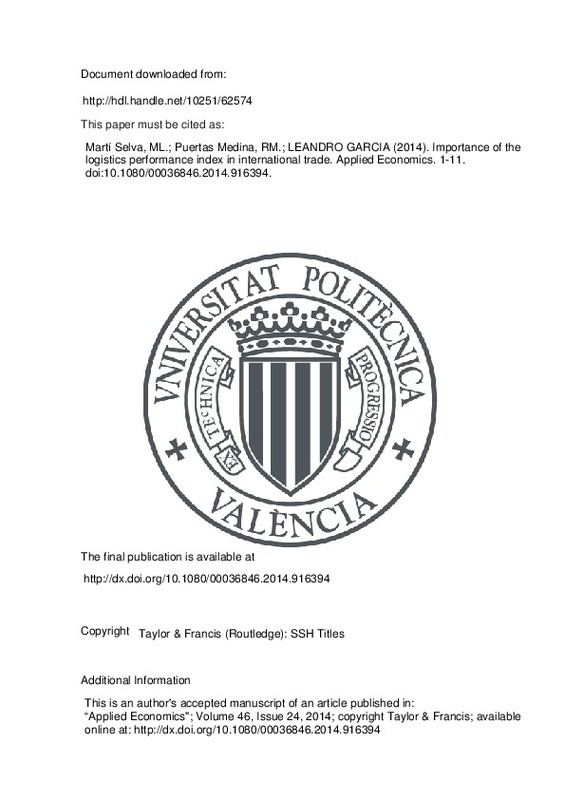JavaScript is disabled for your browser. Some features of this site may not work without it.
Buscar en RiuNet
Listar
Mi cuenta
Estadísticas
Ayuda RiuNet
Admin. UPV
Importance of the logistics performance index in international trade
Mostrar el registro sencillo del ítem
Ficheros en el ítem
| dc.contributor.author | Martí Selva, María Luisa
|
es_ES |
| dc.contributor.author | Puertas Medina, Rosa María
|
es_ES |
| dc.contributor.author | García, Leandro
|
es_ES |
| dc.date.accessioned | 2016-04-14T14:43:23Z | |
| dc.date.available | 2016-04-14T14:43:23Z | |
| dc.date.issued | 2014 | |
| dc.identifier.issn | 0003-6846 | |
| dc.identifier.uri | http://hdl.handle.net/10251/62574 | |
| dc.description | This is an author's accepted manuscript of an article published in: “Applied Economics"; Volume 46, Issue 24, 2014; copyright Taylor & Francis; available online at: http://dx.doi.org/10.1080/00036846.2014.916394 | es_ES |
| dc.description.abstract | Logistics and transport increasingly play a pivotal role in international trade relations. The Logistics Performance Index (LPI) analyses differences between countries in terms of customs procedures, logistics costs and the quality of the infrastructure for overland and maritime transport. The aim of this article is to analyse the impact that each of these components has on trade in emerging economies using a gravity model. Furthermore, the study also attempts to detect possible advances in logistics in developing countries, which are grouped into five regions (Africa, South America, Far East, Middle East and Eastern Europe) by comparing the first LPI data published in 2007 with the most recent data, released in 2012. The results obtained reveal that improvements in any of the components of the LPI can lead to significant growth in a country’s trade flows. Specifically, LPI components are becoming increasingly important for international trade in many countries in Africa, South America and Eastern Europe. | es_ES |
| dc.language | Inglés | es_ES |
| dc.publisher | Taylor & Francis (Routledge): SSH Titles | es_ES |
| dc.relation.ispartof | Applied Economics | es_ES |
| dc.rights | Reserva de todos los derechos | es_ES |
| dc.subject | LPI components | es_ES |
| dc.subject | Logistics | es_ES |
| dc.subject | Gravity model | es_ES |
| dc.subject.classification | ECONOMIA APLICADA | es_ES |
| dc.title | Importance of the logistics performance index in international trade | es_ES |
| dc.type | Artículo | es_ES |
| dc.identifier.doi | 10.1080/00036846.2014.916394 | |
| dc.rights.accessRights | Abierto | es_ES |
| dc.contributor.affiliation | Universitat Politècnica de València. Departamento de Economía y Ciencias Sociales - Departament d'Economia i Ciències Socials | es_ES |
| dc.description.bibliographicCitation | Martí Selva, ML.; Puertas Medina, RM.; García, L. (2014). Importance of the logistics performance index in international trade. Applied Economics. 46(24):2982-2992. doi:10.1080/00036846.2014.916394 | es_ES |
| dc.description.accrualMethod | S | es_ES |
| dc.relation.publisherversion | http://dx.doi.org/10.1080/00036846.2014.916394 | es_ES |
| dc.description.upvformatpinicio | 2982 | es_ES |
| dc.description.upvformatpfin | 2992 | es_ES |
| dc.type.version | info:eu-repo/semantics/publishedVersion | es_ES |
| dc.description.volume | 46 | es_ES |
| dc.description.issue | 24 | es_ES |
| dc.relation.senia | 281506 | es_ES |
| dc.identifier.eissn | 1466-4283 | |
| dc.description.references | Anderson, J. E., & van Wincoop, E. (2003). Gravity with Gravitas: A Solution to the Border Puzzle. American Economic Review, 93(1), 170-192. doi:10.1257/000282803321455214 | es_ES |
| dc.description.references | Bergstrand, J. H. (1985). The Gravity Equation in International Trade: Some Microeconomic Foundations and Empirical Evidence. The Review of Economics and Statistics, 67(3), 474. doi:10.2307/1925976 | es_ES |
| dc.description.references | Bergstrand, J. H. (1989). The Generalized Gravity Equation, Monopolistic Competition, and the Factor-Proportions Theory in International Trade. The Review of Economics and Statistics, 71(1), 143. doi:10.2307/1928061 | es_ES |
| dc.description.references | De Souza, R., Goh, M., Gupta, S.et al.(2007) An investigation into the measures affecting the integration of ASEAN’s priority sectors: phase 2: the case of logistics.REPSF ProjectNo. 06/001d Regional Economic Policy Support Facility, Association of Southeast Asian Nations, Manila. | es_ES |
| dc.description.references | Heckman, J. J. (1979). Sample Selection Bias as a Specification Error. Econometrica, 47(1), 153. doi:10.2307/1912352 | es_ES |
| dc.description.references | Hoekman, B., & Nicita, A. (2010). Assessing the Doha Round: Market access, transactions costs and aid for trade facilitation. The Journal of International Trade & Economic Development, 19(1), 65-79. doi:10.1080/09638190903327476 | es_ES |
| dc.description.references | Iwanow, T., & Kirkpatrick, C. (2009). Trade Facilitation and Manufactured Exports: Is Africa Different? World Development, 37(6), 1039-1050. doi:10.1016/j.worlddev.2008.09.014 | es_ES |
| dc.description.references | Marti, L., Puertas, R., & García, L. (2012). Relevance of trade facilitation in emerging countries’ exports. The Journal of International Trade & Economic Development, 23(2), 202-222. doi:10.1080/09638199.2012.698639 | es_ES |
| dc.description.references | Martínez-Zarzoso, I., & Suárez-Burguet, C. (2000). The determinants of trade performance: influence of R&D on export flows. Applied Economics, 32(15), 1939-1946. doi:10.1080/00036840050155869 | es_ES |
| dc.description.references | Mustra, M. A. (2011) Logistic Performance Index, connecting to compete 2010, inUNESCAP Regional Forum and Chief Executives Meeting, The World Bank, Cairo. | es_ES |







![[Cerrado]](/themes/UPV/images/candado.png)

